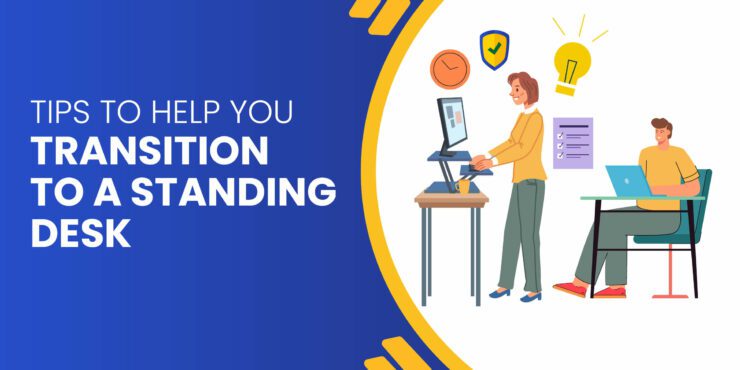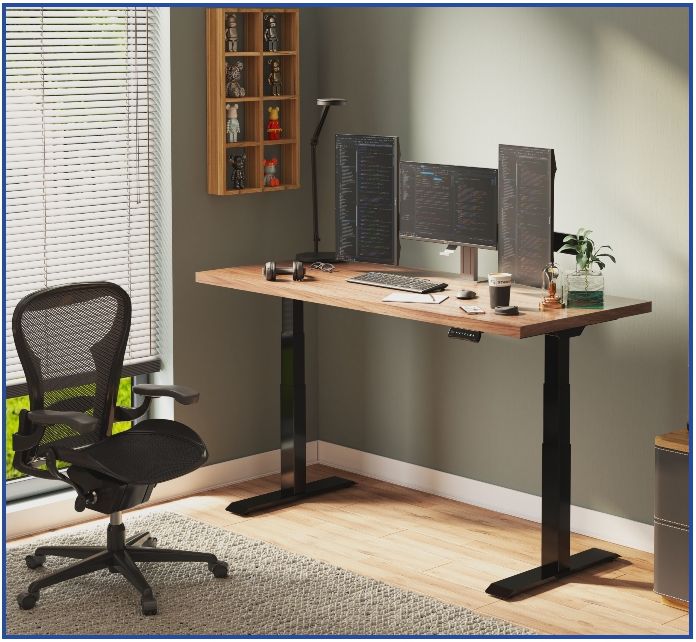Standing desks are a simple solution to help combat sedentary lifestyles and improve posture.
But making the switch is not just about buying a new standing desk. I found this out the hard way, after weeks of struggling to use mine properly.
Learning how to properly integrate this tool into my daily routine made all the difference, which is why I want to help you avoid the common pitfalls of the standing desk transition.
We offer this website completely free to our visitors. To help pay the bills, we’ll often (but not always) set up affiliate relationships with the top providers after selecting our favorites. However, we do our best not to let this impact our choices. There are plenty of high-paying companies we’ve turned down because we didn’t like their product.
An added benefit of our relationships is that we always try to negotiate exclusive discounts for our visitors.
Main Takeaways
- Standing desks offer several health benefits and can improve your work life.
- Adjusting to the new position can be tough, which is why you should gradually transition.
- Ergonomic desk setup sets you up for success
- Ensure you have proper foot support
- Changing up your posture combats fatigue
- Increase standing time slowly, starting with 5 minutes/ hour
- Create a solid routine for standing while working
Why Switch to a Standing Desk?
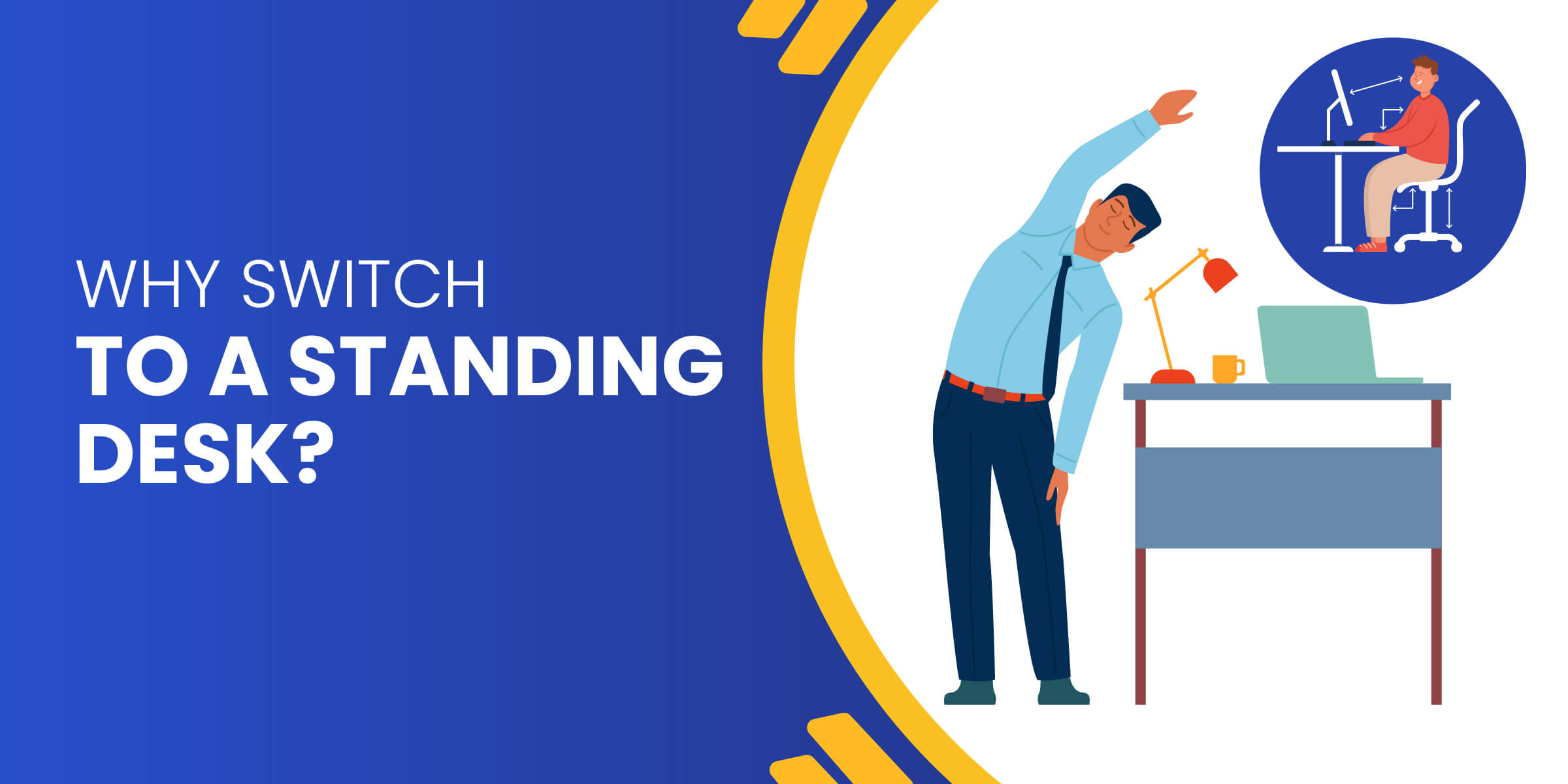

Just as it sounds, the whole point of a standing desk is to allow you to work while standing. The idea of a standing desk can seem odd when you’re used to a traditional sitting one, but there are plenty of important health benefits:
- Improved posture
- More energy throughout the day
- Less back pain
By integrating a standing desk into your routine, you embrace a more active and ergonomically varied work environment.
The Importance of Transitioning to a Standing Desk
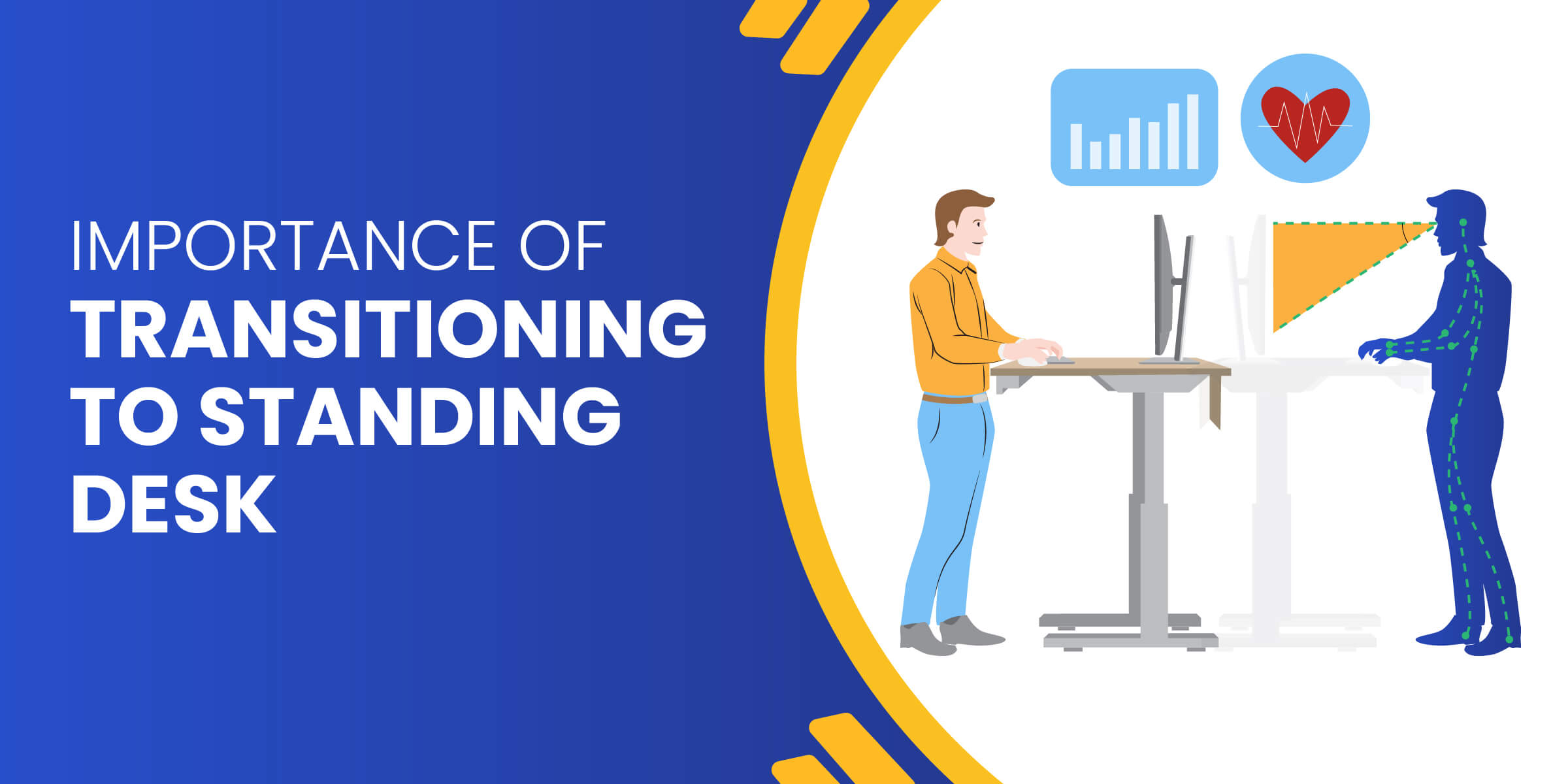

When I first heard of a standing desk, I thought the idea was that you never sit. In reality, it’s more about balancing your day with sitting and standing. Over time, I’ve been able to stand for more of the day, but the point was never to completely replace sitting.
As Harvard Health points out, that’s why the transitioning part is so important. It takes time to adjust to working while standing. Making too large of a change too abruptly is more likely to lead to side effects, like soreness and fatigue. You have to start off slow.
Tips for Transitioning to a Standing Desk


My top tips for transitioning to a standing desk include:
- Ergonomic setup
- Ensure a comfortable, supportive base
- Switch up posture and movements
- Gradually increase standing time
- Create an effective standing routine
Let’s take a closer look.
1. Set Up Your Standing Desk Ergonomically
The top thing I noticed right away when trying a standing desk is that if you’re not comfortable, you won’t use it. Setting up your desk ergonomically is vital for actually experiencing the health benefits it’s capable of.
Ensure that you do not have to strain your eyes, neck, or back to use your standing desk. To do this, I opt for a separate mouse and keyboard (even if I’m using my laptop). I also make sure that my desk is at the proper height so that I don’t have to crane my neck to look down.
2. Standing Desk Comfort and Support
Standing for long bouts can get tiring and lead to lower limb swelling, which is why it’s so important to set yourself up with extra support.
I’ve loved using an anti-fatigue mat to avoid getting tired and sore while standing. A balance pad or anti-fatigue mat encourages tiny movements in your feet and legs, which helps prevent soreness.
Supportive footwear has also been a game changer. I opt for shoes that offer support and comfort.
3. Alternate Postures and Movement
The absolute key for adjusting to my standing desk has been alternating between sitting and standing. Simply put, I don’t force myself to keep standing endlessly. When I start to get stiff or tired, I switch back to sitting for a bit.
Even while using the standing desk, I’ve found alternating postures to be really helpful. My active stool helps take some of the load off of standing without fully resorting to sitting.
Another easy way I add some movement is by taking a few minutes to do some stretches. If I really need more than that, I may even step away to walk around for a minute before returning to work.
4. Gradually Increase Standing Time
Giving yourself time to adjust to your new desk means gradually building into standing. I’d recommend starting out by standing for just 5 minutes per hour during the first week. Doing this every hour helps to build the habit and your stamina.
Then, over time, slowly add more standing time. This gradual increase is vital for a smooth, problem-free adjustment.
5. Build a Standing Desk Routine
One of the biggest challenges I had with my new standing desk was actually sticking to a routine. It’s easy to get sucked into work and forget to change from sitting to standing and vice versa.
Setting a timer is a simple solution to stay on track and make sure you implement standing. I’ve also added mini rewards when I work while standing. For example, I only listen to music during my standing time. This has helped me look forward to it.
Address Common Standing Desk Challenges
When I first tried out my standing desk, I was not thrilled. Adjusting to one can come with some challenges. In addition to the tips above, here are some quick ways to overcome them:
- Boredom– Make using your new office equipment more fun by placing it in a space with a great view. Try pairing standing time with a small fun reward, like music or podcasts.
- Soreness– Like with any new increase in activity, you may get sore. Stretch out after work and use a foam roller to alleviate some of this.
- Forgetting to use it- Give yourself extra reminders by setting alarms. Create a schedule around using the new desk, like sticking to the same time every day.
- Hard to work- Play around with different setups on your desk to make it more comfortable. If that doesn’t help, opt to do certain types of work there. Meetings may be easier for you to do while standing than research-heavy reports.
Get a High-Quality Standing Desk
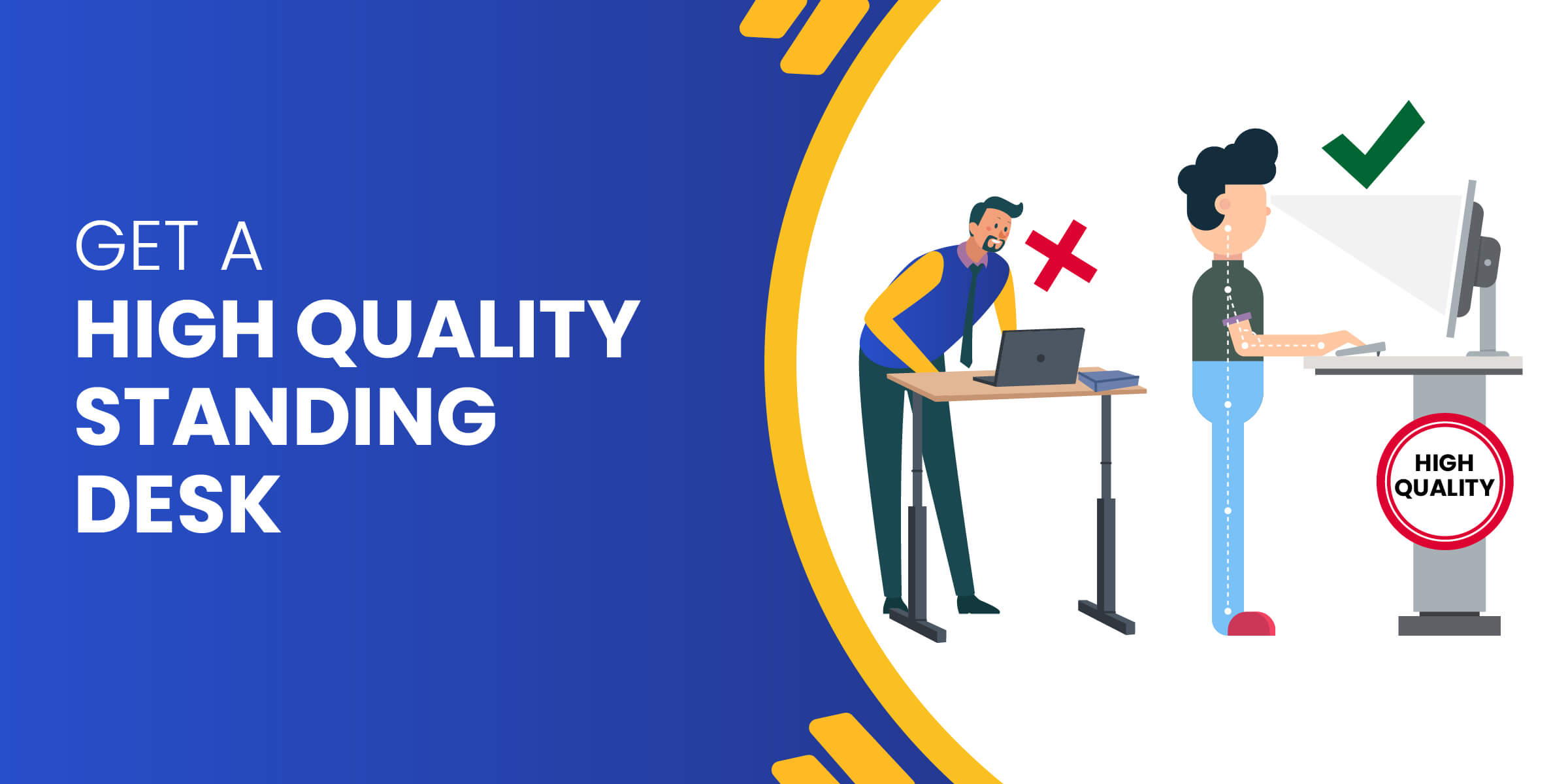

A standing desk can combat a sedentary lifestyle and help keep some aches and pains at bay. As you aim for a healthier work lifestyle, take the time to adjust to using your new standing desk. Gradually increase standing time, use quality footwear, and opt for an ergonomic setup to ensure comfort.
Of course, it all starts with a quality standing desk. I’ve tried out many different brands and models so I could give you the best recommendation. If you’re in search of a standing desk, check out FlexiSpot’s E7 (I’ve already done a full review).
It offers a sleek design and quick assembly, fitting perfectly into my home office. Not only is it sturdy, but also smart. You can program it to automatically adjust to your preferred sitting and standing heights.
FlexiSpot E7 Standing Desk - Why We Recommend
- Extra stability & weight capacity (see what it can do in our video)
- More sizes, tabletops, and shapes available (like the curved front for an ergonomic fit)
- LED touch screen
- Child lock
- 15-Year warranty
Frequently Asked Questions
Are standing desks better for you?
Adding a standing desk to your work routine offers several health benefits, including reducing back pain, improving mood and productivity, and better posture.
Is it hard to get used to a standing desk?
Yes, adjusting to a standing desk can be hard, which is why you should gradually introduce it and balance sitting with standing.
How long does it take to adjust to a standing desk?
It may take a few weeks to adjust to a standing desk. It took me about one month to fully adjust.
How can I transition from a sitting desk to a standing desk?
Begin with short, 5-minute increments of standing, ensure an ergonomic setup, wear comfortable shoes, and use an anti-fatigue mat.
How many hours a day should I use a standing desk?
Ideally, you should use a stand for at least 2 hours in every 8-hour workday.














